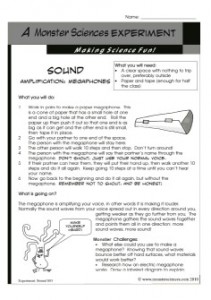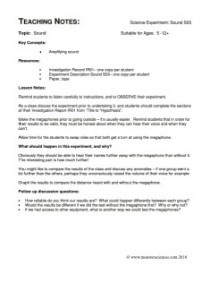Make a simple megaphone to investigate sound amplification.
 |
 |
What you will need:
- A clear space with nothing to trip over, preferably outside
- Paper and tape (enough for half the class)
What you will do:
- Work in pairs to make a paper megaphone. This is a cone of paper that has a small hole at one end and a big hole at the other end. Roll the paper up then push it out so that one end is as big as it can get and the other end is still small, then tape it in place.
- Go with your partner to one end of the space. The person with the megaphone will stay here.
- The other person will walk 10 steps and then stop. Don’t turn around!
- The person with the megaphone will say their partner’s name through the megaphone. Don’t shout, just use your normal voice.
- If their partner can hear them, they will put their hand up, then walk another 10 steps and do it all again. Keep going 10 steps at a time until you can’t hear your name.
- Now go back to the beginning and do it all again, but without the megaphone. Remember not to shout, and be honest!
What is going on?
The megaphone is amplifying your voice, in other words it is making it louder. Normally the sound waves from your voice spread out in every direction around you, getting weaker as they go further from you. The megaphone gathers the sound waves together and points them all in one direction: more sound waves, more sound!
Monster Challenges:
- What else could you use to make a megaphone? Knowing that sound waves bounce better off hard surfaces, what materials would work better?
- Research how an electric megaphone works. Draw a labeled diagram to explain.
Teaching Notes:
Topic:
Sound
Key Concepts:
¨ Amplifying sound
Resources:
- Investigation Record IR01– one copy per student
- Experiment Description Sound S03– one copy per student
- Paper, tape
Lesson Notes:
Remind students to listen carefully to instructions, and to OBSERVE their experiment.
As a class discuss the experiment prior to undertaking it, and students should complete the sections of their Investigation Report IR01 from ”Title to “Hypothesis”.
Make the megaphones prior to going outside – it’s usually easier. Remind students that in order for their results to be valid, they must be honest about when they can hear their voice and when they can’t.
Allow time for the students to swap roles so that both get a turn at using the megaphone.
What should happen in this experiment, and why?
Obviously they should be able to hear their names further away with the megaphone than without it. The interesting part is how much further!
You might like to compare the results of the class and discuss any anomalies – if one group went a lot further than the others, perhaps they unconsciously raised the volume of their voice for example.
Graph the results to compare the distance heard with and without the megaphone.
Follow up discussion questions:
- How reliable do you think our results are? What could happen differently between each group?
- Would the results be different if we did the test without the megaphone first? Why or why not?
- If we had access to other equipment, what is another way we could test the megaphones?



